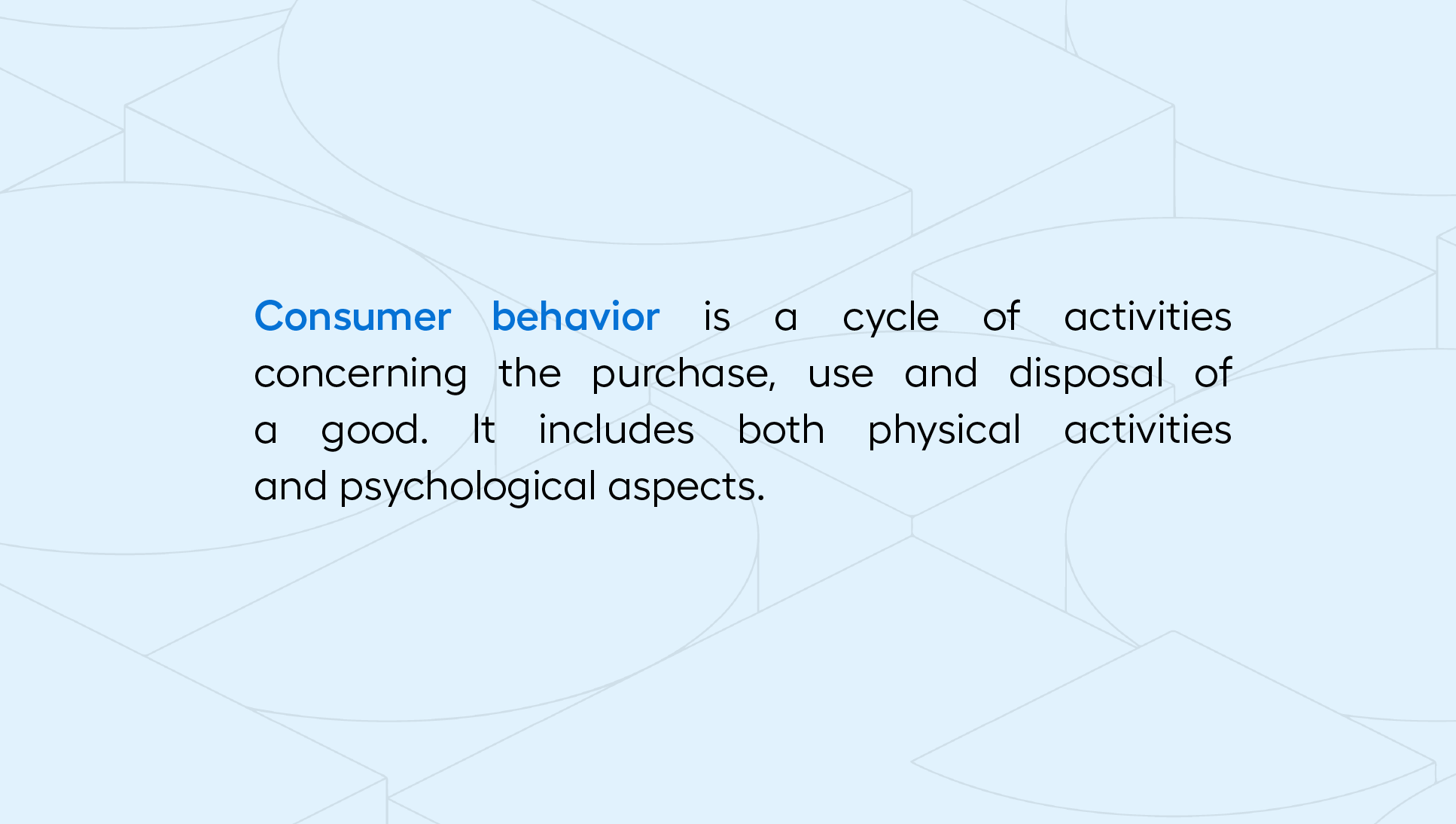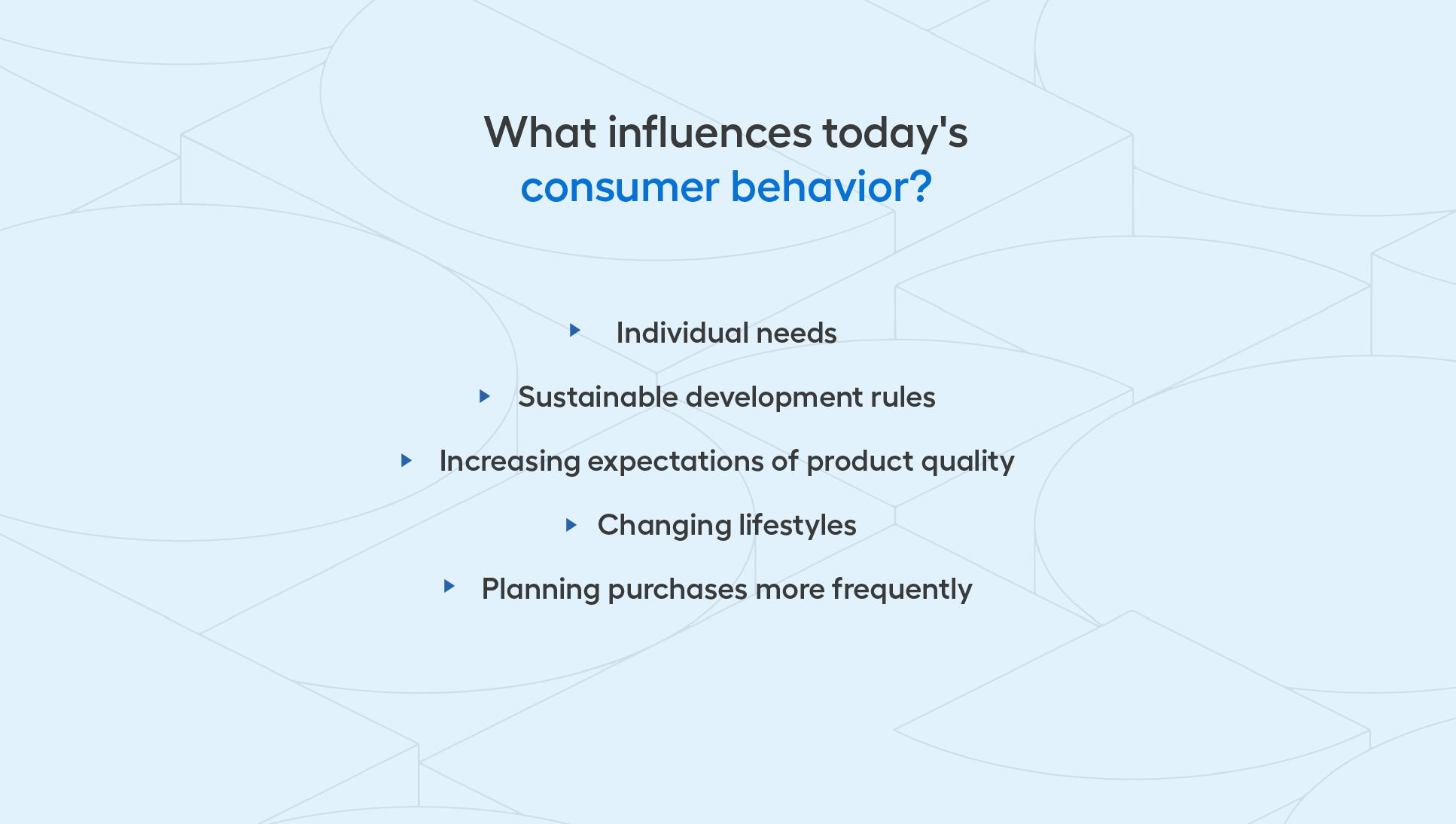In the rush of daily responsibilities, we want to buy quickly. We value convenience and solutions tailored to our needs, and growing social awareness requires us to make decisions in the spirit of sustainability - individuality in choices can be seen at every step of the shopping path. Today, it is difficult to fit the decisions made by different groups of customers into a universal model. Which consumer behaviors do you encounter most often? How to effectively predict the mood of buyers? What characterizes the "consumer of tomorrow"? Answers to all questions will bring you closer to reading this article - learn about market expectations now!
What is consumer behavior?
The way customers make purchasing decisions is not only interesting for business representatives, but is also the subject of research in many scientific fields, including economics, psychology and sociology. Referring to the accepted definition - consumer behavior is a cycle of activities concerning the acquisition, use and disposal of a good. It includes both physical activities and psychological aspects.

In practice, recognizing buyers' habits is a strategic point in eCommerce operation. Running an online store without considering buyer needs can negatively affect future sales results. E-shop owners often identify the source of profit decline in technical errors - in addition to these issues, it is also worth considering whether the sales platform is definitely conducive to the behavior of modern consumers
What characteristics distinguish e-buyers?
Impatient, valuing convenience and intuitiveness, aware and open to innovations - this is how the e-customer is described by the creators of the ShoppingShow report. The online market is constantly evolving, influencing consumer behavior. Meeting the needs of those who use eCommerce services is a challenge and requires constant monitoring of the following changes and emerging trends, which can lose popularity in just a few months. The intensity of changes that sales platforms do not always keep up with is evidenced by the fact a study entitled "Co (u)gryzie e-commerce?" found that as many as 8 out of 10 respondents said that online shopping is not fully satisfactory. How can the industry improve this result? Gaining approval among a larger group of customers requires knowing the motives on which they build their behavior.
eCommerce user vs modern times - what influences consumer behavior?
Changing business realities, uncertainty related to the economic situation, as well as an increasing social awareness - all these factors have caused customers to reformulate the values that guide them when making purchases relative to previous years. However, the formation of consumer behavior does not depend only on external factors - it is also largely influenced by individual characteristics, such as:
- age,
- level of education,
- the environment in which the consumer operates on daily basis (e.g., workplace),
- cultural trends and interests.
Awareness of the above factors can prove essential in planning promotional activities, setting pricing policies or even designing an online store interface. It will also allow you to manage eCommerce more efficiently. For this reason, here are 3 models of consumer behavior worth analyzing.

Price is no longer the center of consumer interest
In the era of inflation, it might seem that price is the most important factor influencing consumer behavior. Despite perceptions to the contrary, other aspects are more important - in the face of rising costs, customers are forced to make informed decisions and are becoming increasingly conscious of the value of money. On the one hand, factors directly related to the product, such as quality or production method, are important to them. On the other - influencing the finalization of a transaction are brand image, convenience and time spent on placing an order, which can be guaranteed by a properly tailored UX, payment catalog or delivery options. Does this mean that consumers in any case no longer pay attention to price?
Many of them still reach for the traditional model of behavior - the search for promotions is an inherent feature of the functioning of market participants. Discount actions or sales are precisely the reason why many people choose to shop. Statistics indicate that. 80% of Poles are able to refrain from buying for several weeks or even months in anticipation of bargains in the store. Only 15% decide to make spontaneous purchases on the spur of the moment. The figures show that promotions are a permanent feature of consumer behavior. For this reason, it is advisable to carefully plan a promotional plan for your online store. Time-limited promotions give a sense of urgency, so they can encourage the buyer to complete the transaction as soon as possible. Cyclical campaigns, on the other hand, allow you to build long-term relationships.
All of the above behaviors fit perfectly into the smart shopping trend, the essence of which is a reasonable approach to planning purchases. Smart shoppers often use the Internet on the grounds that eCommerce is conducive to their shopping style. Among other things, it allows them to compare offers, filter products intuitively, or make easy returns.
Purchases and information - ROPO strategy
The Internet is a reliable tool for quickly collecting information. Before deciding to buy a product, a customer is likely to focus first on acquiring the necessary knowledge about the product or service - visiting review sites, reading the content on the manufacturer's website, and finally comparing possible alternatives. Research conducted by IAB Europe showed that in 2021 as many as 80% of those interested in buying use Google's capabilities when preparing for a purchase. This is the first step on the purchase path when shopping according to the ROPO strategy. What is the core of it?
An extension of the shortcut is 4 words - Research Online, Purchase Offline. Shoppers in this way, find out about a product via the Internet and then purchase it in a stationary store. There is no denying that the growing popularity of this strategy is not beneficial from an eCommerce perspective.
The way to counteract ROPO is to reverse this effect. Online channels offer more attractive prices, streamline shipping and returns processes, and expand assortments to encourage customers to complete the transaction right in the online store. Most often, customers buy products such as consumer electronics, footwear or cosmetics and perfumes this way. Equally popular is the possibility to order products via eCommerce and pick them up later at a stationary store, i.e. the click and collect option. What sets it apart?
The most important advantage is the combination of the benefits of both channels, fostering the described consumer behavior. In addition, it is important to engage the customer at each stage of the purchasing process, providing him with the opportunity to learn about the product, compare it with a similar assortment and, ultimately, purchase it.
Behaviors supported by sustainable development rules
Undoubtedly, we have entered an era of sustainability - consumers are paying more attention than ever to the environmental impact of their own actions, and are demonstrating greater social responsibility, which is increasingly reflected in their decisions. What are the characteristics of a "sustainable" shopping path?
Buyers not only expect responsibility on the part of businesses. They are also willing to change their preferences for the sake of a sustainable future. The report "Odpowiedzialny e-Commerce" prepared by the Chamber of Digtal Economy shows that as many as 60% of respondents take into account whether a seller demonstrates social responsibility when choosing an online store. In addition, some of them are ready to abandon purchases altogether in case of non-compliance with CSR (corporate social responsibility) principles. Significant among these are:
- the way the product is presented - the production process, the materials used or the certificates held are all information that should be presented in detail in product discription,
- environmentally friendly packaging and shipping - customers are paying attention to both the overconsumption of plastic and paper and the delivery of all items in one package. What's more, they are increasingly willing to pay extra for eco-friendly packaging or reducing carbon footprint,
- business fairness - consumers are looking for information on how employees are treated, as well as on a brand's commitment and responsibility to social issues,
- greenwashing concept - a high level of knowledge about environmental changes has contributed to customers not accepting falsely environmentally friendly actions of businesses.
Only 26% of eCommerce respondents indicated that they do not perceive unenvironmental practices in the operation of eCommerce stores. What conclusions should eCommerce owners draw on this basis? Customers are increasingly demanding in their behavior, and meeting their needs requires not only changes in the technological or logistical field, but also continuous education in social and environmental awareness.
Understanding the consumer - how to study customer behavior?
The nature of eCommerce sales deprives many of the chances to assess consumer behavior - it excludes the possibility of conversation or even observing body language. However, this does not mean that the owner of an online store is unable to learn about the needs of his customer. To this end, he can consider conducting surveys, interviews or encourage feedback on the products ordered - such solutions require the sacrifice of additional time and for this reason are often met with reluctance by the recipients. Is there an alternative to study consumer behavior?
A data-driven approach, i.e. running a business based on data analysis, allows you to recognize even the smallest changes in customer behavior that can significantly affect their propensity to buy. Measuring statistics is a good idea to start with the basics and try tools such as Google Analytics or Hotjar. However, numbers alone are not enough to improve customer experience and store performance. What is needed is their proper interpretation, with the important thing being the way the obtained results are collected and presented.
The shoppers of tomorrow - how consumer behavior will be shaped in the future?
Consumer satisfaction is one of the most repeated business buzzwords today. An integral part of keeping shoppers satisfied is understanding their behavior, both current and future. What characterizes the "consumer of tomorrow"?
Growing awareness, authenticity and respect for values - this is the basis for the customers of the future. eCommere owners should not only understand the motives driving sales, but also learn from them and react immediately to changes, changing promotional plans or adjusting online store functionalities. Are you ready to meet the behavior of your consumers?



